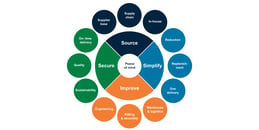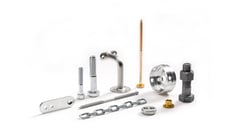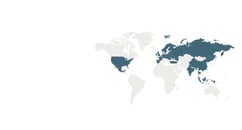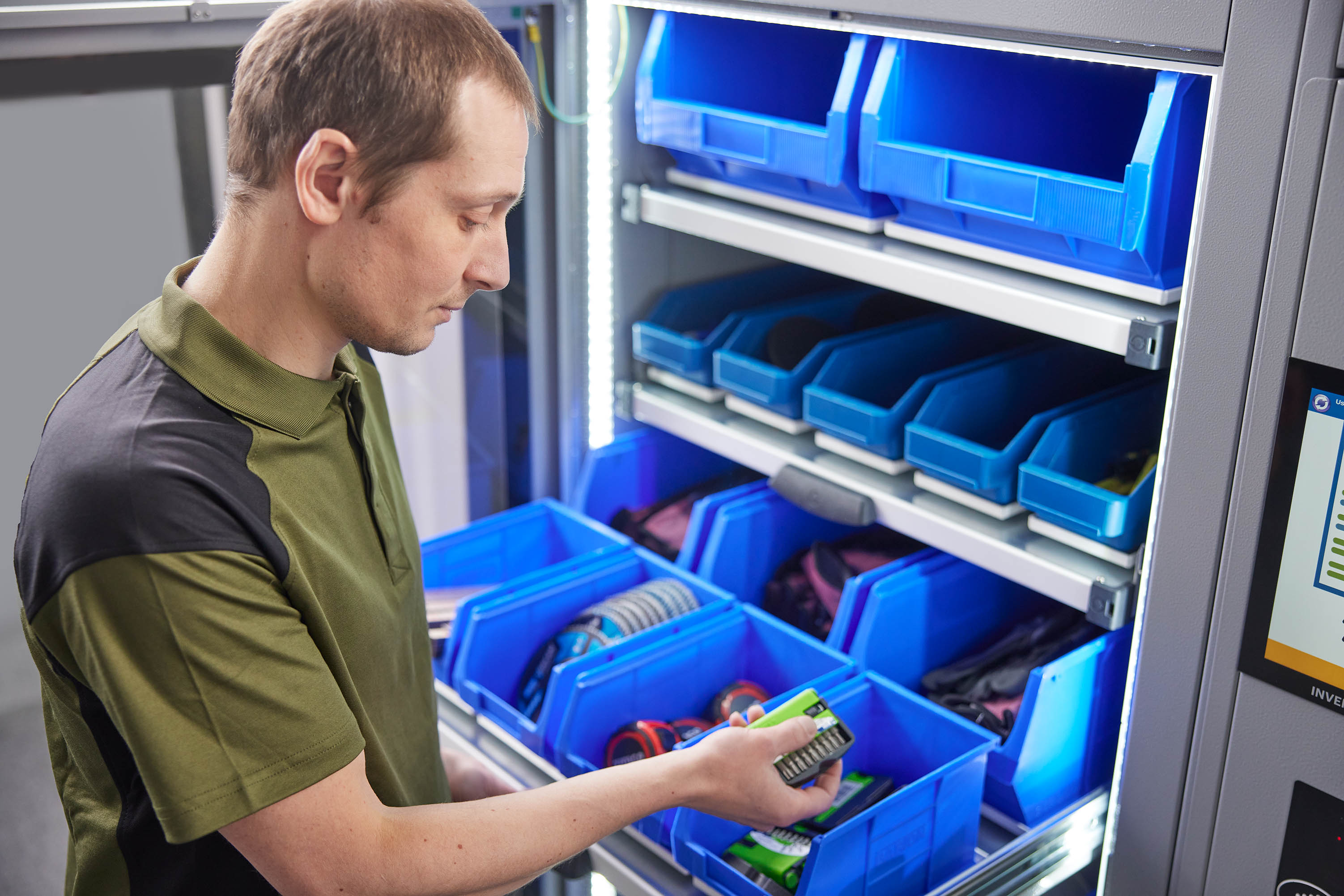Manufacturing companies’ C-parts inventories are complex. They contain all the bolts, screws, nuts, other fasteners, and drawing-bound C-part articles that a company needs for production can easily consist of hundreds of different types of parts and potentially thousands of individual components.
Behind each of these parts is an extensive worldwide network of suppliers, as well as a maze of different supply chains, lead times, ordering processes and shipping practices. Despite this complexity, manufacturers have a constant need to keep track of the inventory and make sure the required parts are available in the right quantity, quality and at the right time. Mistakes in inventory management can easily lead to unexpected parts shortages, which in the worst cases can bring production to a standstill.
For this reason, there’s an urgent need for manufacturing companies to optimize and streamline their C-parts inventories. The inventory needs to provide the highest possible parts availability while keeping administration to a minimum and providing a comprehensive stock overview.
This can be achieved in several different ways – from consolidating and reducing the quantities of parts kept in stock, implementing an ERP system, or introducing automated logistics solutions that order new parts when needed. There are more alternatives available, but they all require cross-departmental collaboration and a change in the way production staff operate. The process of change can be challenging, but the benefits are massive, especially if your company has struggled with manual processes and ‘putting out fires’ in the past.
In this guide, we’ll cover the core essentials of C-parts inventory optimization and provide an introduction to this broad topic. Use the links throughout the guide to jump straight to articles on The Solutionists Hub that cover individual aspects of inventory optimization in more detail.
Chapters
Chapters
What is inventory optimization?
In the article What is Inventory Optimization? published on The Solutionists Hub, Adina Anghel defines an optimized C-parts inventory in this way:
An optimized C-parts inventory gives you trouble-free access to the right C-parts at the right time, in the required quantity and quality. It provides flexibility when your requirements change and gives peace of mind by allowing you to take C-parts availability for granted.”
Inventory optimization is therefore a process that allows you to build a C-parts inventory that matches the definition above. For an operations or logistics manager at a large manufacturing company, an optimized C-parts inventory increases efficiency and saves time, giving them confidence that production won’t be interrupted by any C-parts related issues. For the company, an optimized inventory can lower overall costs, provide better forecasting opportunities, and reduce the amount of administrative work done by purchasers and planners.
In a time of rising production costs and material shortages, it’s more important than ever before for operations and logistics professionals to implement inventory optimization practices to remain competitive and keep customers satisfied. These practices can include the use of software or digitalized replenishment solutions that can take care of stockkeeping and ordering. But sometimes, structural changes are needed – for example, to the number of C-parts suppliers the company works with.
When to optimize your C-parts inventory
Even companies with well-functioning C-parts inventories that already meet their needs could probably still benefit from some optimization. Optimizing a C-parts inventory is a continuous task that is never truly ‘done’. Over time, the demands placed on your C-parts inventory will constantly change along with the types of products you produce, the status of your C-parts supply chains and your production methods.
However, for companies that have never given much thought to their C-parts inventory and face regular headaches due to C-parts availability or delivery issues, the need for optimization is more pressing. These three common issues are good reasons to begin investigating efficiency alternatives, either internally or together with your C-parts suppliers or partners.
You struggle to plan and make forecasts
An optimized inventory is one that gives you access to the parts you need when you need them. Planning and forecasting is a major part of this goal – for example, if your company manufactures highly seasonal products, you have to be sure that your inventory is well-stocked with needed parts during periods of higher demand. This can be difficult when you have to deal with long lead times and supply chain disruptions.
To be able to plan like this, you need to be able to look back at historical data around parts usage, lead times and delivery processes, to make estimates for the future. However, if you’ve previously taken a reactive approach to C-parts rather than a proactive one, or if your system can’t give you these insights, preparing your inventory for the future will be a major challenge.
You rely too much on manual processes
Manual processes often stand in the way of effective optimization. For example, sending someone with a piece of paper to manually check inventory stock levels and see which parts need to be ordered is not an optimized approach. It may work for smaller inventories, but it’s inefficient, vulnerable to human error, and difficult to scale if your company or inventory grows in the future.
A solution that can digitalize or automate this manual task would help create an inventory that predictably provides the needed parts without stealing time and resources from other, more important tasks.
Administration is becoming a burden
This issue is closely linked to the problem of manual processes. Administration around taking stock, placing orders, and coordinating C-parts deliveries is a major time sink – especially when you consider that plenty of manufacturers deal with many different C-parts suppliers. Again, automation and digitalization can reduce the burden of essential day-to-day administration and allow staff to focus on more critical things.
Find out more about how these issues can be solved in a real-world situation in this article: C-Parts Inventory Management Examples from Industry Leaders.
Why should you optimize your C-parts inventory?
Compared to A- and B-parts, which are expensive and highly visible parts of a finished product, C-parts sometimes don’t get the attention they deserve. The fasteners that go into products are often seen as unimportant by some manufacturing companies, mostly because they’re generally very cheap to purchase and fairly generic.
However, the total cost of C-parts is actually much higher than it first appears – and when they’re not managed properly, C-parts can create issues that can generate huge costs for the company as a whole.
Manufacturers with unoptimized C-parts inventories often struggle with unexpected stockouts, extensive administration and sometimes obsolescence. Even though the purchase price of an order of C-parts is almost unnoticeable for a large manufacturer, the costs of managing the inventory improperly can quickly become obvious – particularly if they lead to stops in production due to a shortage of needed parts.
So, even though C-parts are small and inexpensive, they’re no less essential than the A-parts that make up the core of your products. Having an optimized C-parts inventory is a prerequisite for a manufacturing operation that runs smoothly and meets the needs of your customers.
The high total cost of C-parts is the main reason why inventory optimization is important – to find out more about where these costs come from and how they can be reduced, you can find more insights in this article: C-Parts Inventory Costs, and How to Reduce Them.
How to optimize your C-parts inventory
An inventory optimization doesn’t just happen overnight. There are many routes to take, but these are some measures commonly taken by manufacturing companies that struggle with their C-parts inventory and decide to make a change.
Consolidate C-parts suppliers
The more C-parts suppliers you have, the higher the risk of something going wrong. This is sometimes down to human error – if your purchasing processes are highly manual, it’s easier for the purchasing department to miss an order, leaving you with a shortage of parts in production. It also creates numerous inefficiencies and uncoordinated deliveries that take valuable time from production staff. Consolidating to a few or only one supplier streamlines the operation and makes the C-parts store easier to handle.
Digitalize your stock system
Manual stocktaking works for many companies, but it is time-consuming and can still leave you with unexpected shortages, especially if it’s not done on a regular basis. In a situation like this, the risk of mistakes being made can be high. Moving towards an ERP system that is shared across production, purchasing and management boosts transparency and removes some of the unreliable human factors from the process.
Implement a logistics management solution
Once a digital system is in place, logistics management solutions are a logical next step. With solutions like these, the system is updated constantly as parts are used – often by staff scanning barcodes with a handheld reader, or with scale and RFID solutions that track C-part consumption automatically. Solutions like these can also trigger automatic orders, removing the need for manual work altogether.
Continuous improvement
Even when improvements have been made, it’s vital to keep monitoring performance and adjusting as the needs of the business change. When it comes to C-parts inventories, many manufacturers choose to work with a partner who can track the details and come with suggestions for future adjustments.
The challenges of inventory optimization
Just like any change in a complex manufacturing operation, the process of optimizing a C-parts inventory comes with a few challenges.
Cross-department communication
There’s typically no single department who truly ‘owns’ a company’s C-parts operation. Instead, it is a collective effort across multiple teams within the company.
- Sourcing and purchasing is naturally an important component, because this department is responsible for finding the best suppliers, negotiating with them, and ordering the C-parts.
- Logistics is responsible for receiving the shipments of parts from suppliers and transporting them internally to the right place.
- Operations and production is the team that has the most direct contact with the inventory itself.
- Planning must be involved with the inventory to ensure that needed parts are available at specific times.
- Research and development (R&D) may also be involved at some companies. By selecting the right C-parts early on when designing a new product, inventory inefficiencies can be avoided further down the line.
Depending on your company, fewer departments may be involved, or maybe even more. Regardless of your company structure, multiple competencies are required, and several teams need to be involved – each with their own priorities, needs and views on how the inventory should function.
Identifying these needs is an essential first step towards creating an optimized C-parts inventory. But understanding how they can all be met is difficult. Most companies who start an optimization project benefit from working with an external partner who can advise them on the available options and the best choice for them.
A new way of working
Manual processes and unoptimized ways of working with the inventory may be inefficient, but if they’ve been in place for a long time, they can be difficult to leave behind. Making changes in the inventory – for example, by investing in a logistics solution that enables automatic ordering – often requires onboarding and changed behavior for the staff who will work with it. These challenges often pass once the new system has been implemented, however – in many cases, investing in something like an automatic replenishment system results in less work for production staff, operations managers, and purchasers, and therefore creates time that can be spent on other day-to-day tasks.
Make sure to read our article about the challenges that inventory optimization creates on The Solutionists Hub, and get insights into how to overcome them.
The possibilities that inventory optimization creates
One key benefit that an optimized and digitalized inventory brings is predictability. With a replenishment solution that tracks parts usage over time and places orders automatically once availability drops below an agreed level, massive quantities of data are generated. This data allows you to see exactly how much demand there is for each specific part during different periods, which makes it possible to plan your inventory in advance. By taking advantage of this data, you remove the guesswork and make sure you order only the parts you need, while yielding maximum efficiency for the lowest capital.
Additionally, more resources become available when an inventory is optimized. Companies that previously had production staff manually looking in parts bins to check stock, or purchasers manually placing orders from a long list of suppliers, realize that a lot of these repetitive tasks are no longer needed. In some cases, this creates time that can be used more effectively – for example, a purchaser who no longer has as many manual orders to place can instead provide a greater value by consolidating or streamlining the supply chain.









